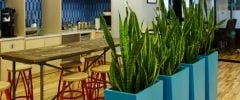The Secret Power of Color in Interiorscape Design

Have you ever stood in a grocery aisle trying to decide which brand of coffee or candy to buy and realized the packaging swayed you? Perhaps you don’t fully understand why you made the decision you did, but marketing experts do. They’ve mastered the art of using color to influence what we buy. Since the 1940s, the study of color and human psychology has gained prominence, yet the fascination dates back even further to ancient civilizations like the Aztecs and Egyptians. As interiorscapers, how can we tap into this knowledge of color psychology?
The Influence of Nature’s Palette
In our industry, we predominantly work with the color green, but have you ever considered its subconscious effects? Understanding these benefits can transform how we design spaces and support well-being and productivity. Here are several ways the color green can influence us:
- Reduces stress and promotes relaxation
- Inspires feelings of hope, renewal, and growth and prompts our brains to think of fresh beginnings and vitality, enhancing our mood and perspective
- Soothes the eyes, making it an ideal choice for work environments as it minimizes eye strain and aids concentration
- Stimulates creativity and innovation, inspiring us to explore new ideas
- Maintains a balance in our energy levels, being neither overly stimulating nor excessively soothing, which helps maintain mental stability and prevent fatigue
- Promotes quicker recovery from illnesses and surgeries by enhancing healing
A Spectrum of Possibilities in Interiorscape Design
While green is a great foundation for interior landscapes, it’s just the tip of the iceberg. We can also offer various benefits from variegated or hybrid plants, as well as a wide selection of container finishes. Do you have accounts in the food industry? Red is a natural choice because it’s known to boost appetite and create a lively, inviting atmosphere—an excellent choice for restaurants and food-related establishments.
On the other hand, blue elicits feelings of loyalty, trust, power, success, confidence, and focus, making it an ideal color choice for any executive demonstrating these traits or offices and conference rooms where concentration is key. How about a pop of yellow to energize and brighten up workspaces, stimulating mental activity and sparking creativity? As you can see below, the use of color goes beyond mere decoration.

How Color Shapes Our World
Is color really that important in the surroundings in which we work, shop, or eat? In short, yes. The power of color in our environments is highlighted by extensive research. Psychologists and institutions such as Harvard have found that color greatly affects our mood, appetite, health, and even our sleep patterns. Furthermore, studies reveal that people subconsciously judge an environment within the first ninety seconds of viewing, and 62 to 90% of that assessment is based on color alone. Knowing this, companies use the power of color psychology to enhance the appeal and perceived effectiveness of their products.
Harnessing Color to Enhance Spaces and Minds
In my personal experience, the color of a room can dramatically affect one’s feelings. I once had a home office with white walls. Despite having a window, I loathed working there, so on a whim, I painted the walls bright red. This change had a mixed reception—a friend felt the room made him feel angry, but it was energizing for me. So much so that I actually found myself spending more time at my desk.
While colors can influence individuals differently, each one elicits some sort of emotional response. Knowing the psychological effects of colors can help us transform ordinary spaces into extraordinary environments that enhance mood, stimulate productivity, and even accelerate healing. As the saying goes, “knowledge is power,” and the power of color is a valuable asset for our sales pitches and designs.
You May Also Like
Leave a Reply
You must be logged in to post a comment.




















